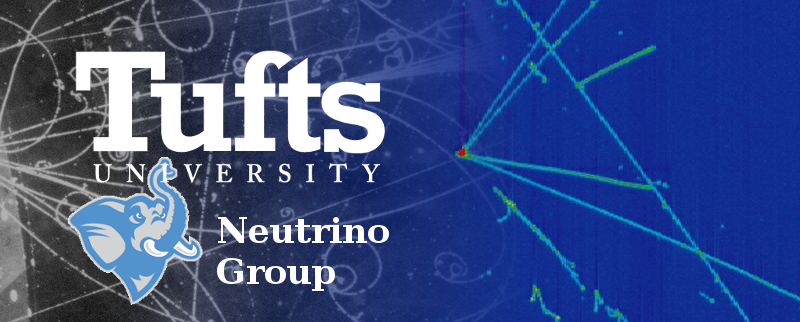Skip to content
MicroBooNE Physics Analyses
- J. Mills. ”A Search for Sterile-Neutrino-Based Muon Neutrino Disappearance Using the MicroBooNe Deep Learning Analysis.” Doctoral Thesis (2022). (FERMILAB-THESIS-2022-11, oai:inspirehep.net:2101691)
Analysis of allowed and excluded parameters for the 3+1 sterile neutrino model using 1-muon-1-proton final state events selected by a DL-based reconstruction our group helped develop. Fits done over muon disappearance parameters, sin2(2theta) and delta-m2. Employs a MC-statistics method (Feldman-Cousin’s) to calculate confidence level contours with proper coverage. Also describes the use of convolutional neural networks with sparse submanifold operations to search over a large event image (3456×1008) for cosmic and neutrino interactions.
- K. Mason. ”A Search for Sterile Neutrino Oscillations in the MicroBooNE Experiment Using Deep Learning Reconstruction and Event Selection.” Doctoral Thesis (2022). (Fermilab Thesis 2022-10)
Analysis of allowed and excluded parameters of a full 3+1 sterile neutrino model using the 1-electron-1-proton and 1-muon-1-proton final state events selected by a DL-based reconstruction our group helped develop. Employs a MC-statistics method (Feldman-Cousin’s) to calculate confidence level contours with proper coverage. Also features the use of Convolutional Neural Networks to identify the location of missing ionization due to unresponsive wires.
- Abratenko, K. Mason, J. Mills, R. Sharankova, T.M. Wongjirad with the MicroBooNE collaboration. “Search for an anomalous excess of charged-current quasi-elastic νe interactions with the MicroBooNE experiment using Deep-Learning-based reconstruction.” Physical Review D 105.11 (2022): 112003. arXiv:2110.14080
Describes an analysis investigating the MiniBooNE low energy excess anomaly. Did not see an excess of events over expectation. If anything, data is consistent with a somewhat low rate.
- Abratenko, K. Mason, J. Mills, R. Sharankova, T.M. Wongjirad with the MicroBooNE collaboration. “Search for an Excess of Electron Neutrino Interactions in MicroBooNE Using Multiple Final State Topologies.” Physical Review Letters, 128.24 (2022): 241801. (arXiv:2110.14054)
Multiple searches looking for an excess of electron neutrino interactions in the MicroBooNE experiment. One of the collaboration’s on-going investigations of the MiniBooNE excess.
Deep Learning Applied to LArTPC Reconstruction and Analysis
- J. Mills, F. Yu, T. Wongjirad with the MicroBooNE Collaboration. “Cosmic muon identification and rejection using a sparse Mask-RCNN Convolutional Neural Network”. Journal of Instrumentation 17 (2022) 09, P09015. (arxiv:2201.05705)
Describes the development of an object-detection network that proposes bounding-boxes around cosmic muon interactions and neutrino interactions in MicroBooNE event images. An advance in the technique is to use sparse submanifold convolutions in order to speed up runtime and deploy on CPUs. Also shown is how one can use the network to improve upon cosmic rejection when combined with the currently deployed method on MicroBooNE.
- K. Mason with the MicroBooNE Collaboration. Electromagnetic Shower Reconstruction and Energy Validation with Michel and $\pi^0$ Samples for the MicroBooNE Deep-Learning-Based Low Energy Excess Analysis. Journal of Instrumentation 16. T12017 (2021) (arxiv:2110.11874)
Describes the shower reconstruction used in our analysis looking at low-energy electrons. Discusses how we checked the method for estimating the energy of showers using showers from neutral pion photons and from electrons made during muon decay.
- Abratenko, K. Mason, J. Mills, R. Sharankova, T.M. Wongjirad with the MicroBooNE collaboration. “Semantic Segmentation with a Sparse Convolutional Neural Network for Event Reconstruction in MicroBooNE.” Physical Review D 103, 052012 (2020) (arXiv:2012.08513)
Describes the deep convolutional neural network developed to label individual pixels of images containing neutrino interactions from MicroBooNE. The advancement here is the use of sparse-submanifold convolutions which allowed us to deploy the network on the existing CPU infrastructure at Fermi National Lab.
- R. Sharankoa and T. Wongjirad. Particle ID in Neutrino Experiments. Chapter in book on “AI in Particle Physics.” IJMPA (2021)
- R. An., P. Abratenko, K. Mason, J. Mills, R. Sharankova, T.M. Wongjirad with the MicroBooNE collaboration, “A Convolutional Neural Network for Multiple Particle Identification in the MicroBooNE Liquid Argon Time Projection Chamber.” Physical Review D 103.9 (2021): 092003. (arXiv:2010.08653)
- C. Adams, K. Terao, T. Wongjirad. “PILArNet: Public Dataset for Particle Imaging Liquid Argon Detectors in High Energy Physics.” arXiv:2006.01993 (2020).
- T. Wongjirad with others. Snowmass LOI: Scalable, End-to-End Optimizable Data Reconstruction and Physics Inference Techniques for Large-scale Particle Imaging Neutrino Detectors (2020).
- R. Sharankova, T.M. Wongjirad et al. (The MicroBooNE Collaboration), Deep neural network for pixel-level electromagnetic particle identification in the MicroBooNE liquid argon time projection chamber. Physical Review D 99 (9), 092001
- A. Radovic, M. Williams, D. Rousseau, M. Kagan, D. Bonacorsi, A. Himmel, A. Aurisano, K. Terao, T. Wongjirad, “Machine learning at the energy and intensity frontiers of particle physics.” Nature 560 (7716) (2018). (osti.gov/1469751)
- MicroBooNE Collaboration. “Convolutional Neural Networks Applied to Neutrino Events in a Liquid Argon Time Projection Chamber.” JINST 12 (03) P03011 (2017)
Generative Models for LArTPC Analysis
- Z. Imani, S. Aeron, T.M. Wongjirad. “Score-based Diffusion Models for Generating Liquid Argon Time Projection Chamber Images.” Accepted to PRD. (arXiv:2307.13687)
Proof-of-principle experiments showing score-based diffusion models can unconditionally generate small images (64×64) of particle trajectories in a LArTPC detector. Uses several types of image quality measures introduced with a first set of benchmarks for future work.
- P. Lutkus, S. Aeron, and T. Wongjirad. “Towards Designing and Exploiting Generative Networks for Neutrino Physics Experiments using Liquid Argon Time Projection Chambers.” International Conference on Learning Representations (ICLR) 2021 workshop on Deep Learning and Simulations. (arxiv:2204.02496)
Describes our attempts to generate LArTPC-like images using a Vector-Quantized Variational Autoencoder or VQ-VAE, a type of generative network. We also introduce the use of Semantic Segmentation as a tool for evaluating image quality.
